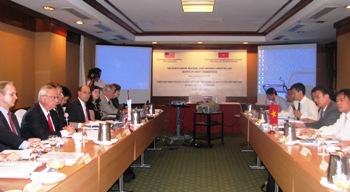VN, US talk of mitigation of three dioxin hotspots
VGP – The 4th annual bilateral meeting of the Việt Nam-US Joint Advisory Committee (JAC) on Agent Orange/dioxin started today in Hà Nội, focusing its discussions on the overall plan to remove dioxin in three airports of Đà Nẵng, Biên Hòa and Phù Cát.
|
|
|
The 4th annual bilateral meeting of the Việt Nam-US Joint Advisory Committee (JAC) on Agent Orange/dioxin started in Hà Nội, September 8 - Photo: VGP |
The meeting will also assess psychological wounds of those exposed to Agent Orange (AO) and the natal malformation in Việt Nam
Vietnamese Deputy Minister of Natural Resources and Environment Nguyễn Xuân Cường asked JAC to place its emphasis on two main issues: dealing with environmental consequences, especially at heavily-contaminated areas, and taking care of AO-infected victims.
After the 3rd JAC meeting in September 2008, a work-team on dioxin pollution was founded to survey the real contamination at the Đà Nẵng Airport and propose responses.
In October 2008, the US Agency for International Development (USAID) announced a fund of US $1 million to assist AO victims.
Earlier this year, the US Congress ratified a US $3-million aid for health activities and removing dioxin in Việt Nam.
JAC co-chairman Kevin Teichman and the authorities of the central city of Đà Nẵng had a working session on Monday to outline a project on building fences around the Đà Nẵng Airport to prevent the expansion of dioxin contamination here.
The average concentration of dioxin at the Airport is 35 parts per trillion of total toxic equivalent (ppt TEQ), 35 times higher than the US allowable rate applied for non-agricultural land.
According to a research by Canadian environment consultation firm Hatfield, the most contaminated sample taken from land at the airport is 365 ppt.
The highest dioxin concentration in blood of local residents is 1,220 ppt, much higher than the industrialized countries in the world.
The US Army was reported spraying some 80 million gallons of defoliants containing nearly 400 kg of dioxin in Việt Nam during the wartime.
By Hồng Vân

